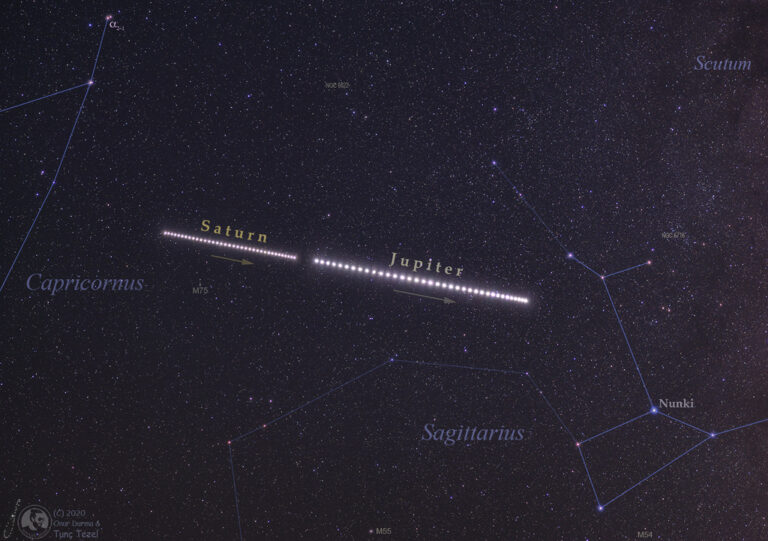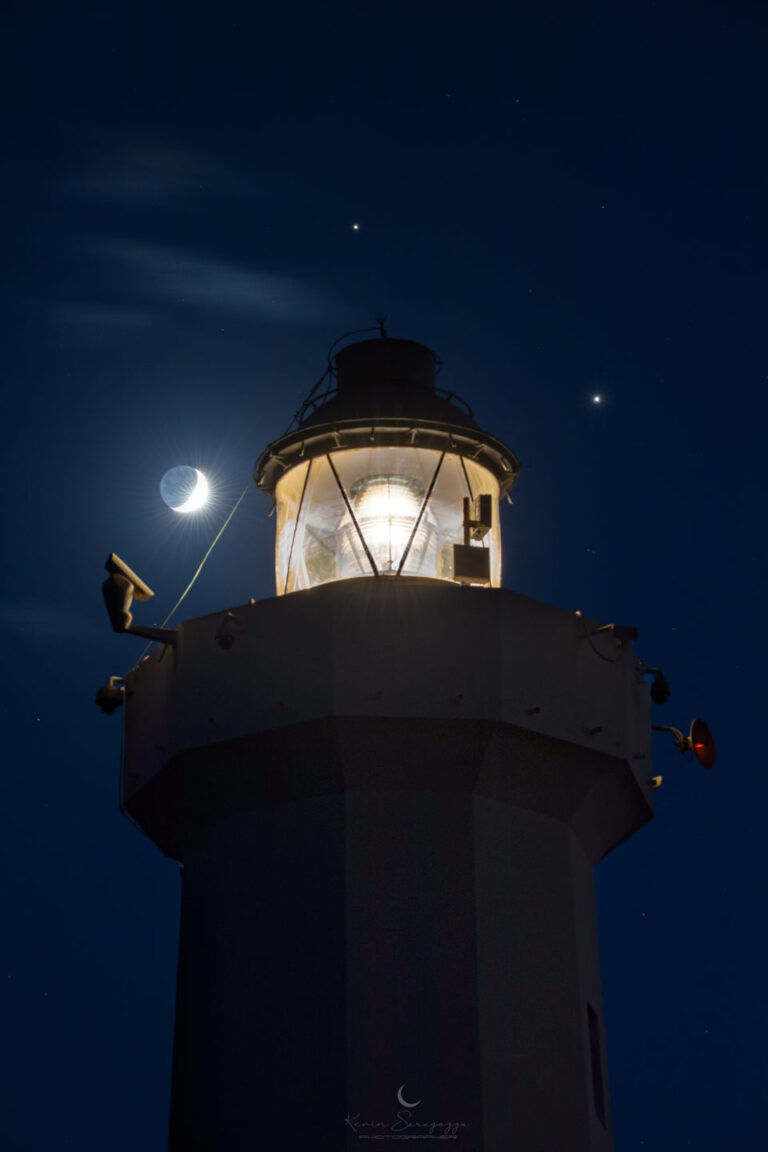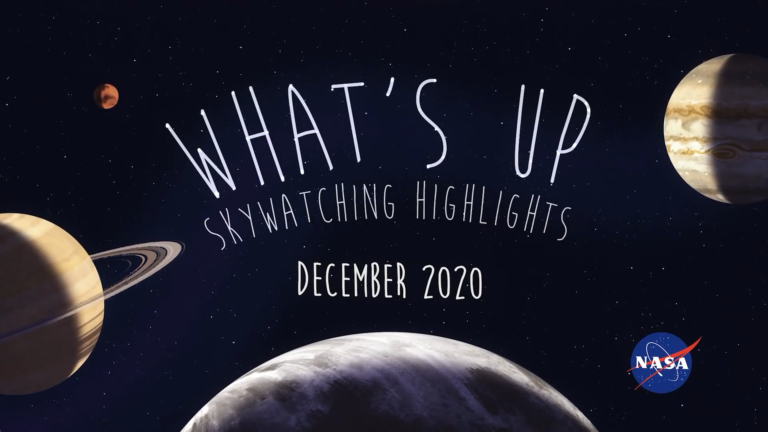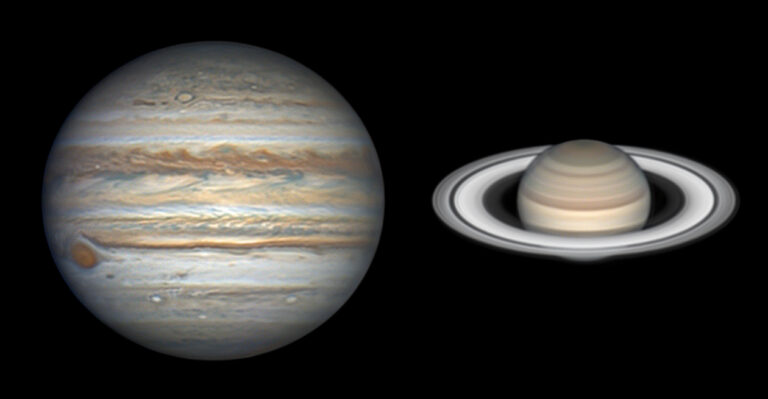土星与木星的大近合
2020年12月13日星期日,在弗吉尼亚州卢雷,雪兰多国家公园日落后拍摄的土星(上方)和木星(下方)。两颗行星在12月21日朝着大近合前进时,彼此之间的距离越来越近,这两个巨行星之间的距离将相差十分之一度。 来源:NASA / Bill Ingalls 天文爱好者迎来了年终盛宴。俗称“圣诞节之星”的是一颗特别活跃的行星结,在接下来的两周里,当明亮的木星和土星近合在12月21日晚上达到顶峰时,很容易在傍晚的天空中看到它们。 1610年,意大利天文学家伽利略·伽利莱(Galileo Galilei)将望远镜对准夜空,发现了木星的四个卫星——木卫一、木卫二、木卫三和木卫四。同一年,伽利略还在土星周围发现了一个奇怪的椭圆形,后来的观测确定这就是土星环。这些发现改变了人们对太阳系的认识。 13年后的1623年,太阳系的两颗大行星——木星和土星一起划过天空。在一次被称为大近合的天文事件中,木星赶上并超过了土星。 “你可以把太阳系想象成一个跑道,每个行星都在自己的跑道上奔跑,而地球则朝着体育场的中心奔跑,”NASA华盛顿总部行星科学部的天文学家亨利·特鲁普(Henry Throop)说。“从有利的角度来看,我们将能够看到木星在内部跑道上,整整一个月都接近土星,最后在12月21日超越木星。” 这两颗行星在太阳系中有规律地掠过,木星和土星的位置大约每20年在天空中排成一条直线。 那么,是什么让今年的奇观如此罕见呢?两颗行星在天空中如此接近地掠过已经过去了近400年,而土星和木星在夜间连成一线也已经过去了近800年,就像2020年一样,这让全世界几乎所有人都见证了这一大近合。 最近的近合将出现在十分之一度的距离,并持续几天。在21号,它们会显得如此接近,以至于与小臂保持一定距离的手指很容易遮盖天空中的两个行星。日落之后,朝西南方向看,将很容易用肉眼看到这些行星。 从我们在地球上的有利位置看,这两颗巨大的气体巨星看上去非常近,但它们在太空中的距离将保持数亿英里。而且,虽然在冬至的同一天发生了近合,但基于行星的轨道和地球的倾斜,时间只是巧合。 “这样的结合可能在一年中的任何一天发生,这取决于行星在它们轨道上的位置。”思鲁普(Throop)说,“近合的日期是由木星、土星和地球在它们绕太阳运行轨道上的位置决定,而至日的日期是由地球轴线的倾斜决定。冬至是一年中最长的夜晚,所以这个罕见的巧合将给人们一个绝佳的机会去外面看看太阳系。” 不知道什么时候该抬头看,在什么地方该抬头看?12月17日星期四,加入思鲁普在#NASAScience Live上谈论大近合的节目。通过使用#askNASA提交你的问题。NASA科学直播将于美国东部时间周四下午3点在NASA电视台和NASA网站上直播,还在NASA的Facebook、YouTube和Periscope频道上同步转播。 对于那些想亲眼目睹这一现象的人来说,可以这样做: 寻找一个没有遮挡天空的地点,例如田野或公园。木星和土星明亮,因此即使在大多数城市也能看到它们。 日落一小时后,望向西南的天空。木星将看起来像一颗明亮的恒星,很容易被看到。土星会稍微暗淡一些,并会出现在木星的上方和左侧,直到12月21日,当木星将超过它,它们将在天空中改变位置。 这些行星可以用肉眼看到,但如果你有双筒望远镜或小型望远镜,你也许能看到木星的四颗大卫星围绕着这颗巨大的行星运行。 每到夜晚,这两颗行星将会在日落后的一个小时内出现在较低的西南方向,如下图所示: 来源:NASA/JPL-Caltech 学习以下如何拍摄行星的技巧和技巧: https://solarsystem.nasa.gov/news/1615/how-to-photograph-the-conjunction-of-saturn-and-jupiter/ 夜空网络: https://nightsky.jpl.nasa.gov/ 木星和土星的访客: https://nightsky.jpl.nasa.gov/news-display.cfm?News_ID=931 想了解更多关于行星近合的知识吗?看看这些资源: https://blogs.nasa.gov/Watch_the_Skies/2015/06/30/jupiter-and-venus-conjunction/ https://youtu.be/sofRYcfaqy0 阅读NASA的这些观察天空的小贴士: https://solarsystem.nasa.gov/whats-up-skywatching-tips-from-nasa/ 参考来源: https://www.nasa.gov/feature/the-great-conjunction-of-jupiter-and-saturn










